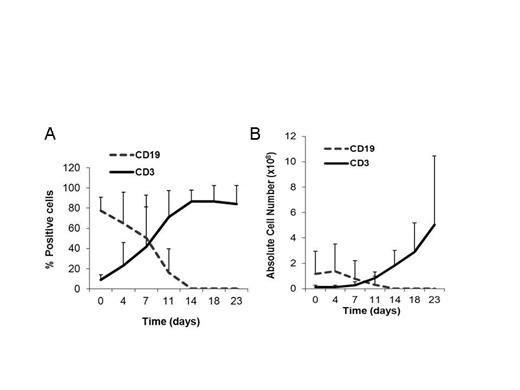Abstract
The combined use of chemotherapy and monoclonal antibodies has proved highly effective for the treatment of CLL but often results in severe life threatening immunosuppression. The development of adoptive therapy with autologous T cells could be clinically relevant to overcome these problems.
We have devised a novel, simple and efficient method for ex vivo expansion of normal autologous T cells from the peripheral blood of CLL patients for adoptive therapy, using blinatumomab (CD3xCD19) and rhIL-2 in serum-free medium. The complete phenotype of in vitro expanded T cells was analyzed by flow cytometry and their cytotoxic activity by calcein release assays.
We performed 18 expansions of T cells, starting from a very small volume of peripheral blood from untreated CLL patients (mean 10.3 ml, range 2-30 ml) that contained a mean of 9.2x106 T cells (range 0.4 to 51x106)(Fig.1). This method allowed reproducible expansion in about 21 days of a mean 410x106 CD3+ T cells (range 71 to 2184x106). The mean fold expansion of T cells in about 3 weeks of in vitro culture was 224 (range 4.4-1326). The only significant contaminant in final Blinatumomab Expanded T cell cultures (BET) were NK cells (mean 18.5%). Indeed addition of blinatumomab and rhIL-2 to the cultures led to a rapid decrease in CLL B cells, which took place from days 7 to 14 onwards and resulted in their complete depletion within 3 weeks (mean 0.2% CLL B cells at days 18-25). Only in one case, a significant percentage of CLL B cells could be observed at the end of culture, but this was due to the particularly high percentage neoplastic cells in the starting population in this patient (98%), resulting in relatively late depletion of these cells, which took place between days 14 and 21, and therefore remained detectable in this case at day 24 (3.8% CLL B cells at day 24). Despite the very low percentage of starting T cells in this specific patient (1.2%), 152x106 T cells could be obtained, equivalent to a 42 fold expansion.
In the 18 expansions performed, the resulting BET cells contained both CD4+ and CD8+ cells in varying proportions (median 46.2% and 44.4% respectively). Only in two cases the final product was composed predominantly of CD4+ cells (95%). Expanded T cells were polyclonal, as shown by TCR Vβ expression which was within the normal range by flow cytometry. Indeed CMV specific clones, detected by CMV peptide (pp65495-503)-loaded HLA-A*0201 tetramer, were expanded using this method and detected in equivalent proportion before and after expansion. Final T cells were composed predominantly of the effector and central memory subsets. Th1 were slightly prevalent over Th2 cells (means 20% and 10%, respectively), whereas Th17 and Treg were less than 1%.
Since CLL derived T cells have been shown previously to have enhanced expression of the synapse regulators CD272 and CD279 compared to normal T cells, leading to impaired immunological synapse formation, we have analyzed these markers in both starting and BET cells from 4 patients. We observed that CD272 and CD279 diminished in BET compared to the starting CLL T populations (from 73% to 19% and 61% to 18%, respectively). These data suggest that stimulation and expansion with blinatumomab and rhIL-2 has normalized expression of these regulators on CLL T cells. Indeed BET were highly cytotoxic against CD19+ targets cell lines or primary CLL cells, with 70-90% lysis at a 3:1 effector target ratio in presence of blinatumomab.
Finally BET were compared to Xcellerated cells expanded using anti-CD3/CD28 Dynabeads and rhIL-2. The expansion protocols using either blinatumomab or anti-CD3/CD28 Dynabeads showed equivalent efficiency and comparable cell composition at the end of culture. Further comparison of the T cell subsets present in BET or CD3/CD28 cultures is in progress.
These data altogether suggest that the use of blinatumomab and rhIL-2 provides a reproducible, simple and GMP-compliant protocol, allowing expansion of large numbers of autologous polyclonal T cells depleted of CLL cells, from relatively small volumes of peripheral blood from CLL patients. This approach is an attractive option for adoptive therapy in these patients after immunosuppressive treatments.
Time course of T cell expansion from CLL peripheral blood using blinatumomab and rhIL-2, shown as percentage (A) and absolute numbers (B) of CD3+ and CD19+ cells. N=13
Time course of T cell expansion from CLL peripheral blood using blinatumomab and rhIL-2, shown as percentage (A) and absolute numbers (B) of CD3+ and CD19+ cells. N=13
No relevant conflicts of interest to declare.
Author notes
Asterisk with author names denotes non-ASH members.


This feature is available to Subscribers Only
Sign In or Create an Account Close Modal